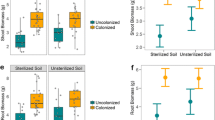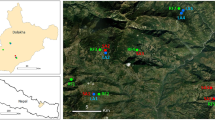Abstract
We investigated belowground responses of Nothofagus alpina seedlings to post-fire conditions during natural regeneration after a wildfire in Chile, focusing on mycorrhizal community and root architecture. The complete root systems of 2-year-old N. alpina seedlings were extracted from a post-fire site with natural regeneration and compared to roots of seedlings from undisturbed forest nearby. Mycorrhizal morphotype richness was determined in each seedling. Morphometric parameters of tertiary root structure and dry biomass of whole root systems were determined in 5 cm vertical intervals and in four lateral root classes. With 43.5% of colonized vital mycorrhizal root tips, the Basidiomycete Descolea antarctica was the most abundant fungal symbiont on post-fire seedlings. Tertiary root morphology of these seedlings was distinct from control plants and characterized by a deep-reaching tap root with rather evenly distributed lateral branches whereas seedlings from the undisturbed site had shallower root systems with most lateral roots concentrated in the upper soil layers. Post-fire seedlings had more mycorrhizal rootlets and mycorrhiza-bearing third order lateral roots than control plants which was expressed in a 34% higher total root number but only a 10% higher total root biomass, although both values were not statistically significant. A major part of these fine roots in seedlings from burnt forest was found in deeper soil horizons, compared to the seedlings from undisturbed forest. According to our results, post-fire conditions clearly favour Descolea antarctica as an early ectomycorrhizal colonizer of Nothofagus seedlings at the studied site. As no significant changes in soil chemistry could be observed at the burnt site, the deep-reaching tertiary root architecture of these seedlings may be interpreted as a response to other abiotic factors like reduced moisture in surface soil.






Similar content being viewed by others

References
Agerer R (1987–2006) Colour atlas of ectomycorrhizae. 1st–13th delivery. Einhorn-Verlag, Schwäbisch Gmünd
Agerer R (1991) Characterization of ectomycorrhiza. In: Norris JR, Read DJ, Varma AK (eds) Techniques for the study of mycorrhiza. Method Microbiol 23:25–73
Agerer R, Beenken L, Bougher NL (2001) Descomyces albus (Klotzsch) Bougher & Castellano+Eucalyptus spec. Descr Ectomyc 5:41–47
Alvarez M, Godoy R, Heyser W, Härtel S (2004) Surface-bound phosphatase activity in living hyphae of ectomycorrhizal fungi of Nothofagus obliqua. Mycologia 96(3):479–487
Anderson IC, Bastias BA, Genney DT, Parkin PI, Cairney JWG (2007) Basidiomycete fungal communities in Australian sclerophyll forest soil are altered by repeated prescribed burning. Mycol Res 111:482–486
Atkinson D (2000) Root characteristics: why and what to measure. In: Smit AL, Bengough AG, Engels C, van Noordwijk M, Pellerin S, van de Geijn SC (eds) Root methods. Springer, Berlin, p 587
Baar J, Horton TR, Kretzer AM, Bruns TD (1999) Mycorrhizal colonization of Pinus muricata from resistant propagules after a stand-replacing wildfire. New Phytol 143(2):409–418
Bastias BA, Xu Z, Cairney WG (2006) Influence of long-term repeated prescribed burning on mycelial communities of ectomycorrhizal fungi. New Phytol 172(1):149–158
Bell DT (2001) Ecological response syndromes in the flora of southwestern Western Australia: fire resprouters versus reseeders. Bot Rev 67(4):417–440
Bell DT, Pate JS, Dixon KW (1996) Relationships between fire response, morphology, root anatomy and starch distribution in south-west Australian Epacridaceae. Ann Bot (Lond) 77(4):357–364
Brundrett M, Bougher N, Dell B, Grove T, Malajczuk N (1995) Working with Mycorrhizas in Forestry and Agriculture. ACIAR monograph 32, Canberra, Australia, 374 pp.
CONAF/ONF (1998) Plan de ordenación Reserva Forestal Malleco. Corporación Nacional Forestal IX Región, Temuco, Chile, p 190
Dahlberg A (2002) Effects of fire on ectomycorrhizal fungi in Fennoscandian boreal forests. Silva Fenn 36(1):69–80
Donoso D (1995) Bosques templados de Chile y Argentina. Editorial Universitaria, Santiago, Chile, p 484
Fujimura KE, Smith JE, Horton TR, Weber NS, Spatafora JW (2005) Pezizalean mycorrhizas and sporocarps in ponderosa pine (Pinus ponderosa) after prescribed fires in eastern Oregon, USA. Mycorrhiza 15:79–86
Gajardo R (1994) La vegetación Natural de Chile. Clasificación y Distribución Geográfica. Editorial Universitaria, Santiago, Chile p 165
Gallo L, Donoso C, Marchelli P, Donoso P (2004) Variación en Nothofagus nervosa (Phil.) Dim. et Mil. (N. alpina, N. procera) (Raulí o Roblí). In: Donoso C, Premoli A, Gallo L, Ipinza R (eds) Variación intraespecífica en las especies arbóreas de los bosques templados de Chile y Argentina. Editorial Universitaria, Santiago, Chile, pp 115–143
Garrido N (1988) Agaricales s. l. und ihre Mykorrhizen in den Nothofagus-Wäldern Mittelchiles. Bibliotheca Mycologica 120, p 528
Godoy R, Palfner G (1997) Ectomicorrizas en Nothofagus alpina (Poepp. & Endl.,) Oerst. y N. dombeyi (Mirb.) Oerst. del sur de Chile. Bosque 10(2):89–98
González ME, Veblen TT (2007) Incendios en bosques de Araucaria araucana y consideraciones ecológicas al madereo de aprovechamiento en áreas recientemente quemadas. Rev Chil Hist Nat 80:243–253
Gronbach E (1988) Charakterisierung und Identifizierung von Ektomykorrhizen in einem Fichtenbestand mit Untersuchungen zur Merkmalsvariabilität in sauer beregneten Flächen. Bibliotheca Mycologica 125, J. Cramer, p 216
Grosse H, Quiroz I (1999) Silvicultura de los bosques de segundo crecimiento de Roble, Raulí y Coigüe en la región centro-sur de Chile. In: Donoso C, Lara A (eds) Silvicultura de los bosques nativos de Chile. Editorial Universitaria, Santiago, Chile, pp 95–128
Guzmán CS (2003) Análisis de suelo y aguas en el sector de Niblinto en la Reserva Nacional Malleco. In: Programa de recuperación de la cuenca Niblinto dañada por incendios forestales. Technical Report, Temuco, Chile
Hambleton S, Sigler L (2005) Meliniomyces, a new anamorph genus for root-associated fungi with phylogenetic affinities to Rhizoscyphus ericae (≡ Hymenoscyphus ericae), Leotiomycetes. Stud Mycol 53:1–27
Hart SC, Classen AT, Wright RJ (2005) Long-term interval burning alters fine root and mycorrhizal dynamics in a ponderosa pine forest. J Appl Ecol 42:752–761
Heusser CJ (1994) Paleoindians and fire during the late Quaternary in southern South America. Rev Chil Hist Nat 67:435–442
Horak E (1971) Studies on the genus Descolea Sing. Persoonia 6:231–248
Izzo A, Canright M, Bruns TD (2006) The effects of heat treatments on ectomycorrhizal resistant propagules and their ability to control bioassay seedlings. Mycol Res 110(2):196–202
Jackson RB, Pockman WT, Hoffmann WA, Bleby TM, Armas C (2007) Structure and function of root systems. In: Pugnaire FI, Valladares F (eds) Functional plant ecology. CRC, Boca Raton, pp 151–173
Jones MD, Durall DM, Cairney JWG (2003) Ectomycorrhizal fungal communities in young forest stands regenerating after clearcut logging. New Phytol 157(3):399–422
Kitzberger T, Veblen TT (1997) Influences of humans and ENSO on fire history of Austrocedrus chilensis woodlands in northern Patagonia, Argentina. Ecoscience 4:508–520
Knoepp JD, DeBano LF, Neary DG (2005) Soil chemistry. In: Neary DG, Ryan KC, DeBano LF (eds) Wildland fire in ecosystems: effects of fire on soils and water. General Technical Report RMRS-GTR-42-vol.4. Ogden, UT: U.S. Department of Agriculture, Forest Service, Rocky Mountain Research Station, pp 63–71
Lehto T (1986) Mycorrhiza formation of scots pine seedlings on peaty and mineral soil. In: Gianinazzi-Pearson V, Gianinazzi S (eds) Physiological and genetical aspects of mycorrhizae. Proceedings 1st European Symposium on Mycorrhizae, INRA, Paris, France, pp 757–760
Neary DG, Ryan KC, DeBano LF, Landsberg JD, Brown JK (2005) Introduction. In: Neary DG, Ryan KC, DeBano LF (eds) Wildland fire in ecosystems: effects of fire on soils and water. General Technical Report RMRS-GTR-42-vol.4. Ogden, UT: U.S. Department of Agriculture, Forest Service, Rocky Mountain Research Station, pp 1–17
Palfner G (1997) Descolea anarctica Singer + Nothofagus alpina (Poepp. & Endl.) Oerst. Descr Ectomyc 2:7–12
Palfner G (2001) Taxonomische Studien an Ektomykorrhizen aus den Nothofagus-Wäldern Mittelsüdchiles. Bibliotheca Mycologica 190. J. Cramer, Berlin, p 243
Palfner G (2002) Cortinarius magellanicus. In: Agerer R (ed) Colour atlas of ectomycorrhizae (1987–2006). Einhorn-Verlag Schwäbisch Gmünd, Germany, p 153
Palfner G, Casanova Katny MA, Read DJ (2005) The ectomycorrhizal community in a chronosequence of Sitka spruce (Picea sitchensis) in North England. Mycorrhiza 15(8):571–579
Rodríguez R, Matthei O, Quezada M (1983) Flora Arbórea de Chile. Universidad de Concepción, Chile, p 408
Schlatter J, Grez R, Gerding V (2003) Manual para el reconocimiento de suelos. 3rd edn. Universidad Austral de Chile, Valdivia, Chile, p 114
Singer R (1950) Descolea antartica género y especie nuevos de Tierra del Fuego. Lilloa 23:255–258
Singer R (1969) Mycoflora Australis. Beihefte Nova Hedwigia 29. J. Cramer, Lehre, Germany, p 405
Singer R, Morello H (1960) Ectotrophic forest tree mycorrhizae and forest communities. Ecology 41(3):549–551
Smith SE, Read DJ (1997) Mycorrhizal symbiosis. 2nd edn. Academic, San Diego, p 603
Torres P, Honrubia M (1997) Changes and effects of a natural fire on ectomycorrhizal inoculum potential of soil in a Pinus halepensis forest. For Ecol Manage 96:189–196
Tuininga AR, Dighton J (2004) Changes in ectomycorrhizal communities and nutrient availability following prescribed burns in two upland pine–oak forests in the New Jersey pine barrens. Can J Res 34(8):1755–1765
Vázquez FM, Rodriguez RA (1999) A new subspecies and two new combinations of Nothofagus Blume (Nothofagaceae) from Chile. Bot J Linn Soc 129:75–83
Veblen TT, Donoso C, Kitzberger T, Rebertus A (1996) Ecology of Southern Chilen and Argentinean Nothofagus forests. In: Veblen TT, Hill RS, Read J (eds) The ecology and biogeography of Nothofagus forests. Yale University Press, New Haven, pp 293–353
Visser S (1995) Ectomycorrhizal fungal succession in jack pine following wildfire. New Phytol 129:389–401
Vrålstad T, Fossheim T, Schumacher T (2000) Piceirhiza bicolorata—the ectomycorrhizal expression of the Hymenoscyphus ericae aggregate? New Phytol 145:549–563
Weinberger P, Ramírez C (1999) Sinecología de la regeneración natural del Raulí (Nothofagus alpina, Fagaceae, Magnoliopsida). Rev Chil Hist Nat 72:337–351
Zhang YH, Zhuang WY (2004) Phylogenetic relationships of some members in the genus Hymenoscyphus (Ascomycetes, Helotiales). Nova Hedwigia 78:475–484
Acknowledgements
We would like to thank the following persons and institutions: CONAF (Chilean National Forest Corporation) for the permission to perform sampling and for sharing site-specific information and field data, especially Miguel Angel Jara, CONAF Temuco and the park rangers of the Malleco forest reserve, Niblinto station, who always gave us professional logistic support during the field work; the Research Department of the La Frontera University, Temuco for assigning research grant PPF 140306 to G. Palfner which funded this study; Dr. Fernando Borie, La Frontera University, Temuco, for the permission to use the facilities of the Chemistry Institute and Rosa Rubio, head of the lab, for her kind, unconditional help and advice; Prof. Pamela Ibarra, Faculty for Agriculture and Forestry, La Frontera University, Temuco, for offering working space and laboratory equipment. Last but not least, we very much acknowledge the effort of the three anonymous referees who helped us to substantially improve the manuscript before publication.
Author information
Authors and Affiliations
Corresponding author
Additional information
Responsible Editor: Hans Lambers.
Rights and permissions
About this article
Cite this article
Palfner, G., Canseco, M.I. & Casanova-Katny, A. Post-fire seedlings of Nothofagus alpina in Southern Chile show strong dominance of a single ectomycorrhizal fungus and a vertical shift in root architecture. Plant Soil 313, 237–250 (2008). https://doi.org/10.1007/s11104-008-9697-y
Received:
Accepted:
Published:
Issue Date:
DOI: https://doi.org/10.1007/s11104-008-9697-y



